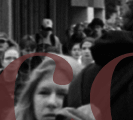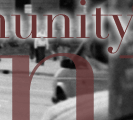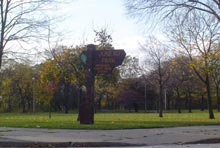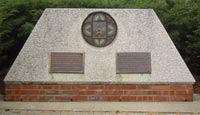 |
||||
      |
||||
|
(everything but the gondola, cont.) However, ethnic groups did not only buy from or provide items to only their own ethnic culture. Dentice and many of his Italian friends often shopped at the other neighborhood stores. There were also many stores owned by Jewish immigrants in Milwaukee, he mentioned, and they carried everything from shoes, to clothes, to food. With so many ethnicities along the shore of Lake Michigan in Wisconsin, one might assume the different heritages and customs would cause tensions among all the ethnic groups. Yet for the most part, Milwaukee residents tolerated and respected each other’s differences, Dentice says. However, soccer, every Italian’s pride and joy, was an exception. “We used to fight with the American kids whenever we played ball,” said Dentice. “This is true because they didn’t want us to play soccer because they thought it was a foreign sport only. They told us, if you want to live in the United States, you have to play football, baseball and basketball. The Americans used to steal the ball away from us.” Because soccer was a sport not foreign to many from eastern and western Europe, the Italians were able to organize soccer leagues and make good friends with peers of different ethnicities residing in and around Milwaukee. If one was to look at the old (and even current) soccer teams of Milwaukee, one would notice their names – the Croatians, the Hungarians, the Bavarians, the list goes on. Each of the teams reveals an ethnic settlement in Wisconsin. When Dentice wasn’t working or playing soccer, he was often hanging out with his friends and family. On Saturday nights, Dentice and 15 of his friends would go to the Eagles Club, or the George DeWine Ballroom, in downtown Milwaukee. It wasn’t just an Italian hangout, but a place to meet Americans and other ethnic groups. Dentice and his friends would often plan trips to Madison and Wisconsin Dells and hunt in Janesville every Sunday just for fun. When they were playing soccer, they often played at Juneau Park on Milwaukee’s lakefront, which still exists today, although at the time it was next to a small airport. The boys would often go to theaters downtown as well as in their neighborhoods, especially the Riverside and Pabst Theaters in Milwaukee, still popular today. Religion was also an extremely important part of Dentice’s life and the Italian lifestyle and culture. The new residents of the Milwaukee area were in need of a priest who spoke Italian, so they opened Our Lady of Pompeii Catholic Church downtown. In addition, residents of the east side of Milwaukee built St. Rita’s Church for themselves. The Pompeii Church, commonly known as the “little pink church,” was eventually destroyed in 1967 to make room for Highway I-794. Fifty-seven years later, Joe Dentice is retired and living in a condo with his wife in Fox Point, a suburb of Milwaukee. Dentice is still involved and dedicated to preserving his Italian culture. For years he served on the board of directors at Milwaukee’s Italian Community Center (ICC) and he continues to volunteer his time every summer to put together the Festa Italiana Sunday mass and procession. Dentice takes pride in his Italian heritage and is constantly striving to keep it alive for the future Italian generations of Milwaukee.
|
Predominant immigrant settlements in Wisconsin during the mid-1800 |
|
|
|||
|
|||
|
|||
|
|||
|
|||


